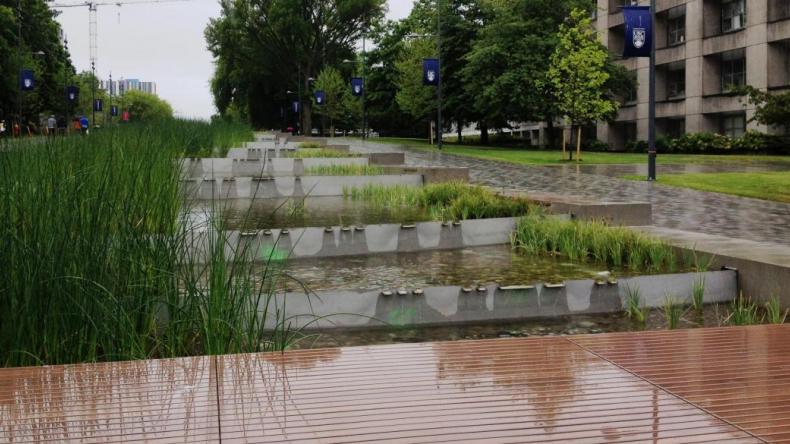
Every year, UBC’s Vancouver campus consumes more than 4.3 billion litres of water, almost all of which is piped in from off campus; at the same time, about 5 billion litres fall on the campus as rainwater. Until recently, most of this precipitation poured into stormwater drains and was discharged into the Fraser River.
But a new approach to landscape design has Dean Gregory, the University’s Landscape Architect, and his colleagues at Campus and Community Planning treating stormwater as a resource, not waste.
“Our Public Realm Plan has allowed us to revitalize a number of campus landscapes in ways that not only address social and economical sustainability, but also environmental sustainability,” says Gregory. “Part of that is creating structures that detain and clean stormwater, and redirect it away from conventional storm drains.”
For example, the new stepped water feature on University Boulevard (header photo) is fed by stormwater from Main Mall. “We do use energy to recirculate that water,” says Gregory, “but all of the planting helps clean the water, so any excess is cleaner than when it first went into the system.
“There is a formality to the University that you cannot escape, and within that framework, this water feature forms an appropriate gateway to campus, one that models the University’s commitment to sustainable principles.”

On Memorial Road east of Main Mall, all the runoff from paved areas is directed into an ornamental planting of native and adapted plants, creating a lush floral experience all year round. “And remember, this was an impermeable parking surface before! As was that stretch of University Boulevard where the water feature now gurgles.”

One of the most striking features of Wesbrook Place — the newest and largest family neighbourhood in UTown@UBC — are the pedestrianized green streets, which include waterways fed by storm water. Runoff from surrounding streets and buildings flows through these waterways into a small lake, which can then be used for irrigation or for water features. This cuts down the neighbourhood’s demand for high-quality, potable water. The lake also helps to clean the water.
“As density increases on campus, water runoff increases too,” explains Gregory. “Management of that runoff becomes more and more important.”
“Before it was a neighbourhood, Wesbrook Place was forest. When it rained, the water was taken up by the trees, nourished the ferns and mosses and so on. Now our approach is that, rather than throwing the excess water away, we are literally and conceptually recycling it, using it for a functional purpose but also to create beauty.”

In Buchanan Courtyards — which were renovated in 2011 — all the water from paved areas is directed into an elegant pool at the base of an open-air pavilion in the West Courtyard. Overflow runs into a rain garden in the East Courtyard, where it nourishes picturesque native planting, and then into a cistern under the pavilion, to be used for irrigation.
“That’s the sort of system we want everywhere,” says Gregory, “where ‘waste’ water is used to create a beautiful landscape, and gets cleaned in the process, so it can then be used for functional purposes, and in turn reduce the need for potable water.”

Water runoff on Agricultural Road — renovated in 2011 — is directed across the surface into swales, then on into a striking rain garden pond.
“The exciting thing is, these aren’t just ditches,” says Gregory. “They’re beautifully designed landscapes that just happen to serve this very functional purpose.
“We do live in a rain forest, and now we can see the water, see where it’s going. By managing stormwater this way, we’re opening a window onto these natural hydrological processes.”
August 9, 2013